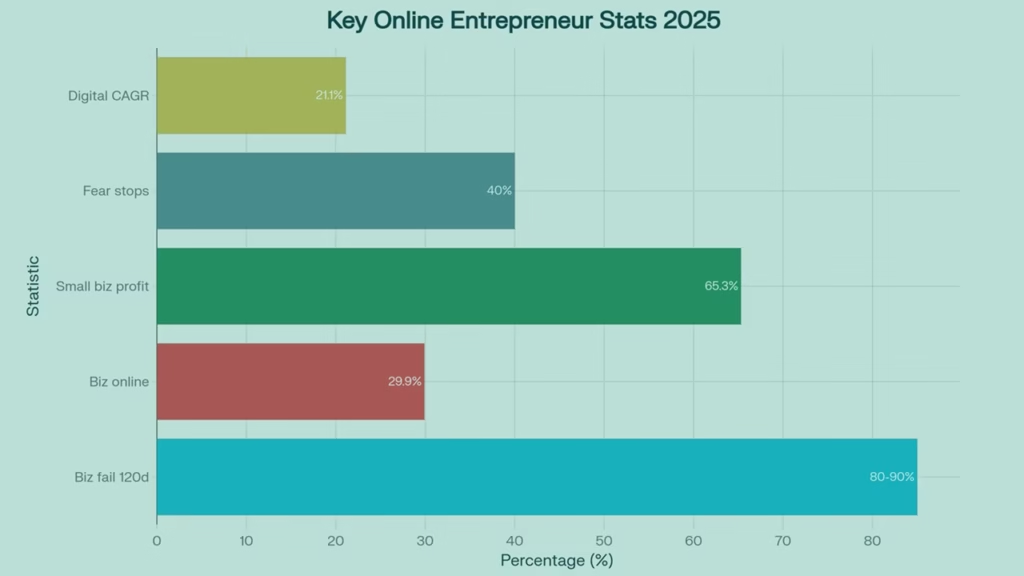In an era where 29.9% of all businesses are now conducted online and global e-commerce sales are set to exceed $4.3 trillion in 2025, the digital entrepreneurship landscape has never been more promising—or more challenging. While statistics show that 80-90% of online businesses fail within their first 120 days, the entrepreneurs who succeed often build empires that transform industries and inspire millions.
This comprehensive guide explores real-world success stories of online entrepreneurs—from both global and Indian markets—sharing how they turned dreams into multi-million-dollar realities and offering actionable insights and proven strategies for aspiring digital business owners.

Key Online Entrepreneurship Statistics for 2025
What Makes a Success Story?

Success in online entrepreneurship extends far beyond financial metrics, though impressive revenue figures certainly capture attention. True entrepreneurial success encompasses multiple dimensions that create lasting impact and sustainable growth.
Financial Achievement remains a primary indicator, but it’s the foundation rather than the destination. When Eric Bandholz built Beardbrand to $100,000 monthly recurring revenue, or when Sahil Lavingia’s Gumroad platform processed over 200 million GMV, these numbers represented not just profit, but proof of market validation and scalable business models.
Innovation and Market Disruption often define the most memorable success stories. Falguni Nayar’s Nykaa revolutionized India’s beauty retail landscape by creating the country’s first comprehensive online beauty platform, eventually achieving unicorn status and a successful IPO. Similarly, Joshua Fields Millburn and Ryan Nicodemus transformed a simple blog about minimalism into a 20-million-person global movement complete with books, documentaries, and sold-out live events.
Community Building and Brand Impact frequently separate temporary successes from enduring legacies. The most successful online entrepreneurs don’t just sell products—they cultivate tribes. Allen Walton’s SpyGuy.com built a $3-million annual business not just by selling security equipment, but by becoming the trusted educational resource for an underserved niche market.
Resilience Through Setbacks often proves the most valuable indicator of long-term success. When Sahil Lavingia had to lay off 75% of Gumroad‘s staff in 2015, many considered it a failure. Instead, he pivoted to a profitable, sustainable business model that now operates with entirely part-time employees while generating substantial revenue. This ability to adapt, learn, and emerge stronger defines true entrepreneurial success.
Success Stories of Online Entrepreneurs: Diverse Models, Real People

The digital entrepreneurship landscape offers countless paths to success, each requiring different skill sets, mindsets, and strategies. The following profiles showcase entrepreneurs who have built substantial businesses across various models and markets.
The Community Builder: Eric Bandholz (Beardbrand)
Profile: Eric Bandholz transformed frustration with corporate conformity into a $100,000-per-month recurring revenue business. As a financial advisor forced to maintain a clean-shaven appearance, Bandholz felt stifled by corporate expectations that conflicted with his personal identity.
Origin Story: The breakthrough moment came when Bandholz attended the West Coast Beard and Mustache Championships in Portland, Oregon. He discovered a large, underserved community of “beardsmen” with no dedicated resources or quality products. Rather than immediately launching a product line, Bandholz spent a year building community through content creation.
Key Challenges & Pivots: Starting with just $8,000 and limited capital, Bandholz faced the challenge of building a business while supporting a growing family. Instead of seeking external funding, he bootstrapped by reselling existing products while building his audience through daily YouTube videos and blog posts. The critical pivot came when a New York Times reporter contacted him for expertise on beard care—Bandholz launched his online store the day before the article published, maximizing the publicity opportunity.
Growth Strategies: Beardbrand’s success stemmed from community-first marketing. By establishing himself as the go-to authority on beard care through educational content, Bandholz built trust before asking for sales. The company developed its own product line in small batches, listening to customer feedback and iterating based on real user needs. This approach allowed them to maintain high quality while minimizing risk.
Impact: Beardbrand now generates over $1.2 million annually with a lean team, proving that niche markets can support substantial businesses. The brand maintains over 1.8 million YouTube subscribers and has become synonymous with quality men’s grooming.
Actionable Insights: Build your audience before building your product. Bandholz succeeded because he became the trusted authority in his niche before attempting to monetize. Focus on education and community building—the sales will follow naturally when you’ve established genuine value and trust.
The Platform Pioneer: Sahil Lavingia (Gumroad)
Profile: At age 19, Sahil Lavingia founded Gumroad after leaving Pinterest as their second employee. His vision: create a platform where creators could easily sell digital products directly to their audience without technical barriers.
Origin Story: Lavingia’s inspiration came from personal frustration with the complexity of selling digital goods online. He built Gumroad‘s initial version in a weekend, focusing on solving one specific problem: making digital commerce as simple as sending a link. This “minimalist entrepreneur” approach prioritized speed and simplicity over complex features.
Key Challenges & Pivots: After raising over $10 million from prestigious investors including Kleiner Perkins, Gumroad faced intense pressure to scale rapidly toward unicorn status. When growth plateaued, Lavingia made the difficult decision to lay off 75% of his team in 2015. This apparent “failure” became the company’s greatest strength.
Growth Strategies: Post-layoffs, Gumroad pivoted to a profitable, sustainable model focused on creator success rather than venture capital metrics. The platform now operates entirely with part-time contractors, maintains healthy profit margins, and processes millions in creator earnings annually. Lavingia documented this journey transparently, building additional credibility and attracting creators seeking authentic partnership.
Impact: Gumroad has enabled over 75,000 creators to earn income from their digital products, from $5 ebooks to $2,000 online courses. The platform’s success proves that sustainable, profitable businesses often outperform high-pressure, venture-backed alternatives.
Actionable Insights: Ship fast and iterate based on real user feedback. Lavingia’s weekend MVP approach allowed him to test market demand quickly and adjust based on actual user behavior rather than assumptions. Don’t let external pressure dictate your business model—sustainable profitability often beats unsustainable growth.
The Market Disruptor: Falguni Nayar (Nykaa)
Profile: At age 50, Falguni Nayar left her lucrative position as Managing Director at Kotak Mahindra Capital to launch Nykaa. With nearly two decades in investment banking, she understood business fundamentals but was entering an entirely new industry.
Origin Story: Nayar’s inspiration came from international travel experiences where she observed sophisticated beauty retail environments like Sephora. She recognized that Indian consumers lacked access to comprehensive, trustworthy beauty platforms combining product variety, education, and reliable service.
Key Challenges & Pivots: Launching Nykaa required significant personal risk—Nayar invested $2 million of her own capital and started with just three employees from her father’s business plus her daughter. The early years were challenging as Indian consumers were hesitant to buy beauty products online, preferring to test products in physical stores.
Growth Strategies: Nykaa succeeded through a hybrid online-offline approach, combining e-commerce convenience with physical showrooms where customers could experience products. The company invested heavily in content marketing, creating educational resources about beauty techniques, product selection, and brand histories. This established Nykaa as not just a retailer but a trusted beauty authority.
Impact: Nykaa commands over 40% of India’s online beauty market and went public in 2021, making Nayar one of India’s first self-made female billionaires. The company has launched over 200 physical stores and represents more than 1,000 beauty brands.
Actionable Insights: Age and experience can be advantages, not obstacles. Nayar’s financial expertise and business maturity enabled her to make strategic decisions that younger entrepreneurs might have rushed. Focus on market education—in emerging markets, success often requires teaching customers why they need your solution, not just what it does.
The Educator-Entrepreneur: Iman Gadzhi (IAG Media)
Profile: Iman Gadzhi dropped out of high school at 17 and built IAG Media into a multi-million-dollar digital marketing education empire. Born in Dagestan and raised in London by a single mother, Gadzhi’s success story embodies the power of self-education and determination.
Origin Story: Gadzhi’s journey began out of necessity—his family’s financial struggles motivated him to find alternative paths to traditional education and employment. He started by offering social media management to local businesses, learning digital marketing skills through trial, error, and intensive self-study.
Key Challenges & Pivots: The biggest challenge was building credibility as a teenage entrepreneur. Gadzhi overcame skepticism by focusing relentlessly on delivering results for clients, documenting his journey transparently, and continuously improving his skills. His pivot from agency services to education came when he realized he could help more people by teaching his methods than by serving clients directly.
Growth Strategies: Gadzhi’s “teach what you do” model created multiple revenue streams. IAG Media served high-paying clients while his education programs like Agency Navigator taught others to replicate his success. This approach built both immediate income and long-term scalability, as educational products require less ongoing time investment than client services.
Impact: Gadzhi’s estimated net worth exceeds $25 million, built primarily through agency services and high-ticket education programs. His YouTube channel and educational content have influenced thousands of aspiring digital marketers worldwide.
Actionable Insights: Skills trump credentials in the digital economy. Gadzhi’s success without formal education proves that practical expertise and results matter more than traditional qualifications. Consider the teaching model—if you’re successful at something, teaching others can multiply your impact and income.
The Lifestyle Brand Builders: The Minimalists
Profile: Joshua Fields Millburn and Ryan Nicodemus, childhood friends from Ohio, transformed their corporate burnout into a 20-million-person minimalism movement. Their story demonstrates how authentic personal transformation can become a sustainable business model.
Origin Story: Both friends achieved traditional success—six-figure incomes, luxury possessions, corporate advancement—yet felt increasingly empty and unfulfilled. Joshua’s pivot began after his mother’s death and divorce occurred within the same month, forcing him to reevaluate what truly mattered. Ryan followed after witnessing his friend’s dramatic life improvement.
Key Challenges & Pivots: The primary challenge was monetizing a lifestyle philosophy without compromising authenticity. They needed to build income streams that aligned with minimalist principles while serving their growing audience. Their solution involved multiple complementary revenue sources: books, speaking engagements, a popular podcast, and a Netflix documentary.
Growth Strategies: The Minimalists succeeded through radical authenticity and consistent value delivery. They documented their transformation journey honestly, including struggles and setbacks. Their content strategy focused on practical advice rather than theoretical concepts, making minimalism accessible to mainstream audiences rather than limiting it to lifestyle enthusiasts.
Impact: Their movement includes multiple New York Times bestselling books, a Netflix documentary viewed by millions, and The Minimalists Podcast with over 200 million downloads. They’ve spoken at major corporations like Google and Apple, proving that lifestyle brands can achieve significant commercial success.
Actionable Insights: Authentic transformation creates compelling content. The Minimalists succeeded because they genuinely lived their message—audiences can detect authenticity from miles away. Build multiple content formats around your core message to reach different audience preferences and create diverse revenue streams.
The Niche Market Master: Allen Walton (SpyGuy.com)
Profile: Allen Walton built SpyGuy.com from a $1,000 starting investment into a $3-million annual business by focusing on an underserved niche: security and surveillance equipment for everyday consumers.
Origin Story: Walton’s journey began when he worked at a local spy shop, learning that average consumers—not just law enforcement—needed surveillance equipment for legitimate personal and business purposes. When he realized online options were limited and often unprofessional, he saw an opportunity to serve this overlooked market.
Key Challenges & Pivots: The biggest challenge was building trust in a sensitive market category. Many customers felt uncomfortable purchasing surveillance equipment and needed education about legal usage and product selection. Walton addressed this by creating extensive educational content and maintaining exceptional customer service.
Growth Strategies: SpyGuy‘s success came from combining niche expertise with educational marketing. Instead of just selling products, Walton became the trusted authority on surveillance equipment for legitimate users. His content marketing strategy included detailed product guides, legal usage information, and customer education that built confidence in both the products and the brand.
Impact: The business now generates over $3 million annually with a small team, proving that specialized knowledge in niche markets can support substantial enterprises. Walton’s approach has been featured on major podcasts and business publications as an example of successful niche marketing.
Actionable Insights: Niche markets can be more profitable than broad markets if you become the definitive authority. Walton succeeded by deeply understanding his customers’ unique needs and concerns, then addressing them comprehensively. Focus on education and trust-building in sensitive or complex product categories.
The Content Monetization Expert: Sharon Gourlay (Digital Nomad Wannabe)
Profile: Sharon Gourlay transformed her travel blog from a personal journal into a $50,000-per-month income stream, ultimately earning enough to purchase a house in Melbourne from her blog sale proceeds.
Origin Story: Gourlay’s transformation began in 2013 when she was a stressed part-time teacher and full-time mother seeking better work-life balance. Inspired by other family travel bloggers, she decided to monetize her existing travel blog and document her journey from “$0 to success” on Digital Nomad Wannabe.
Key Challenges & Pivots: The main challenge was learning technical skills like SEO and affiliate marketing while managing family responsibilities. Gourlay overcame this by treating her business education as seriously as formal schooling, dedicating every spare moment to learning and implementing new strategies. Her family’s transition to digital nomadism created urgency that accelerated her learning curve.
Growth Strategies: Gourlay’s success came from mastering SEO and affiliate marketing fundamentals. She focused on creating valuable content that ranked well in search engines, then monetized through strategic affiliate partnerships. Her transparency about income and methods on Digital Nomad Wannabe built additional credibility and attracted aspiring entrepreneurs seeking proven strategies.
Impact: At peak performance, Gourlay’s blogs generated $8,000-$15,000 monthly from affiliate marketing alone. She ultimately sold her travel blog and several niche sites for over three times annual profits, using proceeds to purchase a family home. Her success enabled both parents to work from home full-time while traveling during school holidays.
Actionable Insights: SEO knowledge remains one of the most valuable digital skills. Gourlay’s success proves that mastering search engine optimization can create sustainable passive income streams. Document your journey transparently—teaching others your methods can become an additional income source while building credibility.
The Bootstrap Builder: Fernando Raymond (ClickDo & SeekaHost)
Profile: Fernando Raymond immigrated from Sri Lanka to the UK, working minimum-wage jobs before self-teaching SEO and WordPress skills to build two successful companies: ClickDo (digital marketing agency) and SeekaHost (web hosting).
Origin Story: Raymond’s entrepreneurial journey began out of necessity while working at McDonald’s and other minimum-wage positions. He recognized that digital skills could provide freedom and better opportunities, so he dedicated himself to learning SEO and web development through online resources and experimentation.
Growth Strategies: Raymond’s success came from reinvesting every dollar back into business growth while maintaining extremely frugal personal expenses. He built both companies organically without external funding, scaling revenue by consistently delivering results for clients and gradually expanding service offerings. His content marketing strategy positioned him as an SEO expert, attracting both clients and students.
Key Challenges & Pivots: The primary challenge was building credibility as an immigrant entrepreneur with non-traditional credentials. Raymond overcame this by focusing relentlessly on results, building case studies of successful client projects, and sharing his knowledge freely through content marketing. His pivot into web hosting came naturally as ClickDo clients requested hosting recommendations.
Impact: ClickDo now employs 14 staff members globally and has helped hundreds of UK businesses grow online. SeekaHost serves thousands of customers with affordable hosting solutions. Raymond’s success enabled him to achieve his goal of location independence, managing operations remotely while traveling.
Actionable Insights: Self-taught skills can be just as valuable as formal education if you focus on practical application and results. Raymond’s success proves that consistent learning, frugal reinvestment, and customer-focused service can build substantial businesses from minimal starting capital. Consider vertical integration—Raymond’s move from agency to hosting created additional revenue streams from existing relationships.
What Can You Learn from These Stories?

Analyzing successful online entrepreneurs reveals consistent patterns and strategies that transcend individual circumstances, industries, and geographic locations. These insights provide actionable frameworks for aspiring digital business owners.
Common Success Patterns
Skills Before Scale emerges as perhaps the most critical factor. Every profiled entrepreneur invested heavily in developing practical, valuable skills before attempting to scale their businesses. Eric Bandholz became an expert in men’s grooming and community building. Sahil Lavingia mastered product development and user experience. Falguni Nayar understood both finance and consumer behavior. This pattern suggests that sustainable success requires deep competence in areas directly related to customer value creation.
Community-First Approach characterizes nearly every success story. Rather than focusing immediately on sales, these entrepreneurs built audiences, educated markets, and established trust relationships before monetizing. The Minimalists grew their following for years before launching paid products. Allen Walton became the go-to authority on surveillance equipment before scaling his product offerings. This approach creates more sustainable businesses because customers feel genuine connection rather than just transactional relationships.
Authentic Documentation provided competitive advantages for multiple entrepreneurs. Sharon Gourlay’s transparent income reporting on Digital Nomad Wannabe built credibility that attracted both customers and students. Sahil Lavingia’s honest discussion of Gumroad‘s challenges and pivots strengthened rather than weakened market position. Iman Gadzhi’s documentation of his journey from dropout to millionaire created powerful social proof for his education programs.
Strategic Patience with Tactical Speed appears throughout these stories. Entrepreneurs moved quickly on implementation—Lavingia built Gumroad‘s MVP in a weekend, Bandholz launched his store within days of the New York Times opportunity—but remained patient about long-term results. This balance allows for rapid market testing while avoiding premature scaling before product-market fit is established.
Turning Weaknesses into Strategic Advantages
The most inspiring aspect of these success stories involves how apparent disadvantages became competitive strengths through strategic reframing and focused action.
Financial Constraints Drove Innovation in multiple cases. Allen Walton’s $1,000 starting budget forced him to focus on proven, profitable activities rather than expensive experiments. Fernando Raymond’s minimum-wage background created fierce determination to reinvest every dollar rather than lifestyle inflation. Eric Bandholz’s family responsibilities demanded efficient, bootstrap-friendly growth strategies. These constraints forced entrepreneurs to develop sustainable, profitable business models rather than relying on external funding that might enable wasteful spending.
Lack of Traditional Credentials Became Authenticity Advantages for several entrepreneurs. Iman Gadzhi’s high school dropout status resonated with audiences frustrated by traditional education limitations. The Minimalists’ corporate burnout story connected with millions experiencing similar dissatisfaction. Sharon Gourlay’s “ordinary mum” background made her digital nomad journey more relatable than expert-led content. These authentic stories created deeper audience connections than polished, credential-heavy alternatives.
Niche Focus Enabled Market Domination where broader approaches might have failed. Beardbrand’s focus on “beardsmen” allowed Eric Bandholz to become the definitive authority rather than competing in the massive men’s grooming market. SpyGuy’s specialization in surveillance equipment enabled Allen Walton to charge premium prices and build customer loyalty in a sensitive, trust-dependent category. This pattern suggests that going narrow and deep often proves more profitable than going broad and shallow.
Geographic or Cultural “Disadvantages” Created Unique Positioning for international entrepreneurs. Falguni Nayar’s Indian market focus enabled her to build the definitive beauty platform for a underserved but rapidly growing market. Fernando Raymond’s immigrant perspective helped him understand the challenges faced by other non-native entrepreneurs seeking digital opportunities. These differences became strengths when properly positioned and leveraged.
The Critical Role of Community, Branding, and Adaptability
Authentic Community Building distinguishes sustainable businesses from short-term successes. The most successful entrepreneurs created genuine value for their audiences before requesting financial support. They shared knowledge freely, responded to community feedback, and built trust through consistent helpful behavior. This approach requires more patience than aggressive sales tactics but creates much stronger foundations for long-term growth.
Brand Authenticity Over Polish characterizes the most successful stories. None of these entrepreneurs started with professional branding, perfect websites, or polished content. Instead, they focused on genuine value creation and authentic communication. Their brands evolved naturally as their businesses grew, maintaining authenticity even as they achieved scale. This suggests that perfectionism often delays launch more than it improves outcomes.
Adaptability Through Market Feedback enabled pivots that strengthened rather than weakened these businesses. Sahil Lavingia’s dramatic staff reduction led to a more sustainable business model. The Minimalists’ evolution from corporate burnout story to global lifestyle brand expanded their impact significantly. Sharon Gourlay’s pivot from personal travel blog to business education created multiple revenue streams. These entrepreneurs stayed true to core values while remaining flexible about specific tactics and strategies.
Common Themes & Myth-Busting

The entrepreneurial landscape is filled with misconceptions that can mislead aspiring business owners and create unrealistic expectations. Analyzing real success stories reveals important truths that counter popular myths about online business building.
The “Overnight Success” Myth
Most Success Takes Years of Consistent Effort despite social media portrayals suggesting otherwise. Eric Bandholz spent over a year building his audience before launching Beardbrand‘s product line, then several more years reaching significant revenue milestones. Falguni Nayar invested nearly two decades in financial services before launching Nykaa at age 50—her “overnight success” actually represented three decades of skill development and market observation.
The pattern across all profiled entrepreneurs shows incremental progress punctuated by breakthrough moments rather than sudden, inexplicable success. Sahil Lavingia’s apparent quick rise with Gumroad masked years of programming practice, startup experience at Pinterest, and countless hours of product development iteration. Sharon Gourlay’s $50,000 monthly income peak came after years of learning SEO, building content, and optimizing monetization strategies.
Preparation Meets Opportunity explains most “sudden” successes. When the New York Times reporter contacted Eric Bandholz, he was prepared to capitalize because he had spent months building expertise and content around beard care. When Iman Gadzhi’s education programs took off, he had years of agency experience providing credibility and practical knowledge to teach. The appearance of overnight success often masks extensive preparation periods.
Redefining Success Metrics
Profitability Often Matters More Than Revenue in sustainable business building. Sahil Lavingia’s realization that Gumroad remained profitable despite layoffs led to a more sustainable business model than his original venture-backed approach. Fernando Raymond’s bootstrap approach created immediate profitability that funded reinvestment and growth without external pressure or equity dilution.
Quality of Life Improvements frequently motivate entrepreneurs more than pure financial gains. Sharon Gourlay’s success enabled both parents to work from home while traveling regularly—the lifestyle improvement mattered as much as the income increase. The Minimalists built their business around personal values of simplicity and authenticity, creating alignment between business success and personal fulfillment.
Impact and Community Metrics provide meaning beyond financial returns. Allen Walton takes pride in educating customers about legal, ethical surveillance equipment usage. Falguni Nayar’s Nykaa democratized access to quality beauty products across India. These entrepreneurs measure success partially through positive impact on their communities and customers.
The Critical Role of Mindset: Resilience, Learning, and Customer Focus
Growth Mindset Over Fixed Expertise characterizes every successful entrepreneur profiled. None started as experts in their eventual fields—they became experts through obsessive learning and practical application. Fernando Raymond taught himself SEO and WordPress. Sharon Gourlay learned affiliate marketing and SEO as a busy mother with no technical background. This pattern suggests that willingness to learn continuously matters more than starting knowledge levels.
Customer Needs Over Personal Preferences guide successful business decisions. Eric Bandholz built Beardbrand around what the beard community needed, not just what he personally wanted to create. Allen Walton addressed customer education needs in the surveillance market rather than just selling products. Falguni Nayar combined online convenience with offline product testing because Indian beauty customers demanded both experiences.
Resilience Through Multiple Failures builds strength for eventual success. Sahil Lavingia’s “failure” to build a billion-dollar company led to a more sustainable and personally satisfying business model. Iman Gadzhi faced skepticism as a teenage dropout but used it as motivation to prove capabilities through results. The Minimalists‘ corporate burnout experience provided authentic content that resonated with millions facing similar challenges.
Long-term Vision with Short-term Flexibility enables navigation through inevitable obstacles and market changes. These entrepreneurs maintained clear visions about the value they wanted to create while remaining flexible about specific tactics and strategies. They pivoted when necessary but never compromised their core commitment to serving customers effectively.
The evidence suggests that sustainable online business success requires patience, continuous learning, authentic customer focus, and resilience through inevitable challenges. The most successful entrepreneurs view obstacles as learning opportunities and maintain long-term perspectives while executing with daily discipline and focus.
How to Start Your Own Journey

Transforming entrepreneurial inspiration into actionable progress requires systematic approach and realistic expectations. The success stories examined provide a practical framework for beginning your own online business journey.
Actionable Implementation Checklist
Start with Skills Assessment and Development. Before launching any business, honestly evaluate your current capabilities and identify skill gaps that matter for your chosen market. Eric Bandholz dedicated months to learning about men’s grooming and community building before launching Beardbrand. Fernando Raymond invested extensive time mastering SEO and WordPress before serving clients.
Action steps: List skills directly related to your business idea. Identify the top three most critical gaps. Commit to learning one new skill per month through online courses, books, or practical projects. Document your learning process—this content can later become valuable marketing material demonstrating your expertise development.
Identify and Research Your Target Market Deeply. Every successful entrepreneur profiled understood their customers’ problems, preferences, and purchasing behaviors before building solutions. Falguni Nayar observed international beauty retail trends and recognized gaps in the Indian market. Allen Walton understood that ordinary consumers, not just security professionals, needed surveillance education and equipment.
Action steps: Choose a specific, narrow target audience rather than trying to serve everyone. Spend time in forums, social media groups, and communities where your potential customers gather. Ask questions, read discussions, and identify recurring problems or complaints. Create detailed personas based on real people you could serve.
Build an MVP (Minimum Viable Product) Quickly. Rather than perfecting products in isolation, successful entrepreneurs test market demand with basic versions of their solutions. Sahil Lavingia built Gumroad‘s initial version in a weekend to test core functionality. Sharon Gourlay started with a simple blog and basic affiliate links before developing sophisticated content strategies.
Action steps: Define the smallest possible version of your product or service that provides genuine value. Set a deadline of 30-60 days maximum to launch this basic version. Focus on core functionality rather than aesthetic perfection. Plan to iterate based on early customer feedback rather than trying to predict every feature need.
Establish Authority Through Content Creation. Nearly every profiled entrepreneur built audiences and credibility before attempting to monetize directly. The Minimalists documented their lifestyle transformation journey. Iman Gadzhi shared his agency-building process transparently. This approach creates trust and positions you as an expert worth following.
Action steps: Choose 2-3 content formats that align with your strengths (writing, video, podcasts, social media posts). Commit to publishing valuable content consistently—quality matters more than quantity, but consistency builds momentum. Share your learning process, customer success stories, and industry insights that demonstrate expertise.
Focus on Customer Problem-Solving Over Self-Promotion. The most successful entrepreneurs prioritized customer value creation over personal promotion. Allen Walton became known for educating customers about legal surveillance equipment usage. Eric Bandholz built his reputation by helping men feel confident about growing and maintaining beards.
Action steps: For every piece of promotional content, create at least three pieces of educational or helpful content. Answer customer questions thoroughly and publicly when possible. Share customer success stories and lessons learned from failures. Build relationships through genuine helpfulness rather than sales pressure.
Common First-Step Mistakes to Avoid
Perfectionism Paralysis prevents many potential entrepreneurs from launching at all. Unlike the successful entrepreneurs studied, many beginners spend months or years perfecting products that haven’t been tested with real customers. This approach wastes time and resources while delaying valuable market feedback.
Trying to Serve Everyone dilutes marketing messages and makes it difficult to build expertise or community. Successful entrepreneurs like Eric Bandholz (beardsmen) and Allen Walton (surveillance customers) succeeded by serving specific groups extremely well rather than trying to appeal to broad markets.
Underestimating the Learning Investment Required leads to frustration when quick success doesn’t materialize. Every profiled entrepreneur invested significant time developing skills directly related to their business success. This learning period is necessary investment, not wasted time.
Neglecting Community Building in Favor of Direct Sales creates transactional relationships rather than loyal customer bases. The most sustainable businesses grew from authentic communities where entrepreneurs provided genuine value before requesting financial support.
Setting Realistic Timeline Expectations
Based on the success stories analyzed, realistic milestones for new online entrepreneurs include:
Months 1-6: Foundation Building. Focus on skill development, market research, content creation, and MVP testing. Expect little to no income during this period while you establish credibility and understand your market deeply.
Months 6-18: Validation and Iteration. Refine your offering based on customer feedback, build systems for consistent content creation and customer service, and begin generating modest income. This period involves significant learning and adjustment.
Months 18-36: Growth and Scaling. With validated products and established audiences, focus on scaling what works, expanding service offerings, and building sustainable business systems. Most profiled entrepreneurs achieved significant milestones during this timeframe.
Years 3+: Optimization and Expansion. Mature businesses focus on optimizing existing operations, expanding to new markets or products, and building long-term sustainable competitive advantages.
The evidence suggests that sustainable online business success requires 2-3 years of focused effort before achieving substantial results. Entrepreneurs who understand this timeline can maintain motivation through inevitable challenges and setbacks while building businesses with lasting impact and profitability.
Conclusion
The journey from aspiration to successful online entrepreneur is challenging but achievable for those willing to commit to continuous learning, authentic customer service, and long-term persistence. The diverse success stories examined—from Eric Bandholz’s community-driven men’s grooming empire to Falguni Nayar’s revolutionary Indian beauty platform—demonstrate that there is no single path to digital business success.
However, consistent patterns emerge: successful entrepreneurs develop valuable skills, serve specific markets exceptionally well, build authentic communities through helpful content, and maintain resilience through inevitable setbacks and challenges. They start small, iterate based on real customer feedback, and scale gradually rather than seeking overnight transformation.
Most importantly, these entrepreneurs succeeded not despite their limitations but because they transformed constraints into competitive advantages. Limited budgets forced innovation and efficiency. Lack of credentials created authenticity that resonated with audiences. Niche focus enabled market dominance that broad approaches couldn’t achieve.
The digital economy offers unprecedented opportunities for motivated individuals to build businesses that provide both financial success and personal fulfillment. With 665 million entrepreneurs worldwide and 65.3% of small businesses achieving profitability, the entrepreneurial landscape continues expanding. Yet 40% of potential entrepreneurs remain paralyzed by fear of failure, missing opportunities to create value for themselves and their communities.
The success stories in this comprehensive guide prove that ordinary people with extraordinary commitment can build businesses that transform industries, inspire communities, and create lasting impact. The question isn’t whether online entrepreneurship offers viable paths to success—the evidence overwhelmingly confirms it does. The question is whether you’re ready to begin your own journey from dream to reality.
Your success story starts with the first step. Choose your market, develop your skills, serve your customers exceptionally well, and maintain persistence through the inevitable challenges ahead. The digital economy is waiting for your unique contribution to its continuing evolution and growth.
